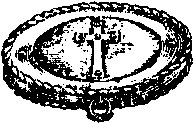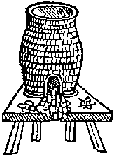![]()
Gode
Cookery Presents

True stories, fables and anecdotes from the
Middle
Ages

The Host was also used as a love-charm, sometimes with foul words written around it, or with evil prayers intercalated at Mass. In 1273, a woman, to regain her husband's love, placed the Host, laid upon a tile, on live coals. It then became flesh, dripping blood. She buried it in a heap of manure, where it remained for seven years. Meanwhile wonderful things happened, and the woman at last confessed to a priest, who found the flesh and blood intact. They were preserved for many years, uncorrupt and undissolved, as precious relics. Jacques de Vitry has a story of a woman who intended to use the Host as a love-charm. She retained it in her mouth, but it changed to flesh and adhered to her palate, so that she could not speak. A licentious priest also kept the Host in his mouth, intending to kiss a woman and bend her to his will through its power. Leaving the church, he became so tall that he struck his head on the roof. In terror he drew the Host from his mouth and concealed it. Then, going to another priest, he confessed. Both then went to the place of concealment and found a small figure of a crucifix made of flesh and blood. Excerpts from:
Medieval
Faith and Fable by J.A. MacCulloch.
Boston: Marshall Jones Company Publishers, 1932. In the modern Catholic church, a Pyx (from the Latin word pyxis, meaning box) refers to the vessel used to carry the Host to the ill. In earlier times, however, the term was applied to all containers which held the Eucharist. The pyx is an attribute of St. Clare of Assisi who, according to legend, placed a pyx containing the Host on the threshold of her convent which was under attack. The beseiging infidels immediately threw down their weapons and fled, and a miracle was proclaimed.  A
Pyx A
PyxExcerpts from:
Signs
& Symbols in Christian Art by George
Ferguson. New York: Oxford University Press, 1961. In the Middle Ages, Rocamadour in France was one of the more famous pilgrim centers. There the sword Durandal, which had belonged to Roland, was treasured. Here too, besides relics of saints, votive offerings brought by the faithful were found in abundance. Jewels, rich vestments, & gold and silver ornaments had been deposited over the years to win the favor of heaven for their donors, along with numerous tresses of women's hair, reminders of a story long associated with the shrine. A woman pilgrim, famed for her beauty, had through loose living become blind. On the way to Rocamadour she prayed to the Virgin that her sight might be restored. This was granted, but on her arrival, she was not allowed to enter the shrine. While she was confessing her sins outside to a priest, he looked at her fair face and said, "Dear friend, I fear these lovely tresses of yours have done great hurt to those who have gazed at them. Offer them now in honor of God and our Lady." The tresses were cut and carried into church on a pole and there placed with others, similarily surrendered. The lady followed, to give thanks to the Virgin for her salvation. But on the homeward journey, like Lot's wife, the shorn beauty looked regretfully back, bemoaning the loss of her hair and wishing she had it again. Her wish was immediately granted, but with her hair her blindness also returned. Excerpts from: Life in Medieval Times by Marjorie Rowling. New York: The Berkely Publishing Group, 1979. Robert
Manning tells the tale of a woman who lived with a "right amorous
priest" for many years and bore four sons, three of whom became
priests, the fourth a scholar. After their father died, the four sons
urged the mother to repent her "deadly sin." The mother, however,
declared that she would never repent "while I have you three priests to
pray and chant for me and to bring me to bliss." The mother died
"sooner than she willed." For three nights her sons sat by her body at
the wake. On the first, at midnight, to their terror, "the bier began
to quake." On the second night it quaked again and suddenly a devil
appeared, seized the corpse, and dragged it toward the door. The sons
sprang up, carried it back, and tied it to the bier. On the third night
at midnight a whole host of fiends invaded the house and
Took
the body and the bier
With loathly cry that all might hear And bore it forth none knows where Without end forevermore. The scholar son then roamed the world advising women not to become "priests' mares," less they suffer his mother's fate. Excerpts from: Life in a Medieval Village by Frances & Joseph Gies. New York: HarperCollins Publishers, 1990. |
 A Medieval
beehive
A Medieval
beehive